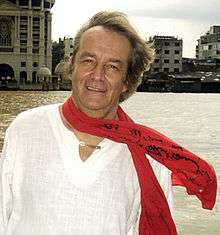Titus Leber
| Titus Leber | |
|---|---|
 | |
| Born |
March 2, 1951 Zell am See, Salzburg Austria |
| Occupation | Film director, screenwriter |
| Website | http://titusleber.com |
Titus Leber (born 2 March 1951) is a writer and director of films based on classical music.
Biography
Titus Leber was born in Zell am See, Austria. He studied at the Lycée Français de Vienne, where he received a baccalaureate degree in 1969 and a PhD in mass media communication in 1975. His doctoral thesis, The Multilayer Method, explored the history and cultural use of superimposed images.
During his graduate studies, Leber worked on documentaries and became head of the film department of the Institut für Neurovegetative Endoskopie in Düsseldorf. He collaborated with the founder of the Institute, Dr. Raimund Wittmoser, on the endoscopy documentaries Hyperhidrosis and Neue Coelome.
Leber's first fictional 16 mm short film, 1976's "Kindertotenlieder", Songs of Dead Children won awards at the Valladolid International Film Festival, the Cannes Film Festival, and was Austria's nominee for best short film for the Academy Awards. In 1978, he wrote and directed Schubert- Fremd bin ich eingezogen ("Schubert- A Stranger I came"), for which he won the Austrian National Award for filmmaking.
After a year at the American Film Institute, from where he graduated with a director's diploma in 1979, Leber returned to Austria to write and direct. His first feature film, Anima-Symphonie Fantastique (1981) was shown out of competition at the 1981 Cannes Film Festival.[1]
From 1983 to 1984 Leber took a research fellowship at MIT's Center for Advanced Visual Studies. His project, the "Image Reactor", explored interactive image permutation. He returned to Europe fascinated by the possibility of making the audience participate in what happened on the screen, and began work on interactive multimedia.
In 1987 he produced "Vienna Interactive", an interactive touchscreen laserdisc, followed by "Mozart Interactive" in 1991. Between 1992 and 1997 Leber worked with the Louvre Museum, IBM, the Pasteur Institute, and the Centro Nacional de Cultura, Lisboa on interactive multimedia projects. He also served on the advisory board of Corbis and the executive board of La Fémis, the French cinema school.
In the late-1990s Leber moved to Bangkok, where he worked with the Mae Fah Luang Foundation on multimedia, notably What Did the Buddha Teach?, an interactive installation about the life and teaching of Buddha.
From 2009-2013 he worked on the project "Borobudur- Paths to Enlightenment- a comprehensive interactive exploration of the Borobudur Temple in Central Java" for Taman Wisata Candi Borobudur and the Government of Indonesia, and on the 90-minute TV film "Lalitavistara- The Life of Lord Buddha as shown on the Borobudur Temple". He published two books: Lalitavistara and Decoding Borobudur for Cyberspace.
Filmography
- Anima - Symphonie phantastique
- Fremd bin ich eingezogen
- Kindertotenlieder
TV productions and documentaries
- Sangharadja-Thailands Supreme patriarch
- Symphony from the New World ( Based on A. Dvorák's 9th Symphony, in collaboration with NASA).
- Nuclear requiem: For ORF/Austrian Television
- Neue Coelome: Introducing new methods of endoscopy.
- Hyperhidrosis: Award for best Film by German Endoscopic Society
Multimedia
- Borobudur- Paths to Enlightenment
- What Did the Buddha Teach?
- Mozart Interactive
- Vienna Interactive
- Le monde de Pasteur
- The Great Louvre
- Eight Historical Cities of Portugal
- Das Wiener Theatermuseum.
- Endoskopie Interaktiv
References
- ↑ "Festival de Cannes: Anima - Symphonie phantastique". festival-cannes.com. Retrieved 2009-06-07.